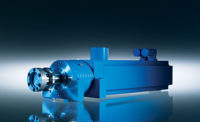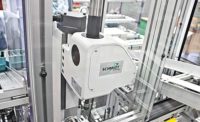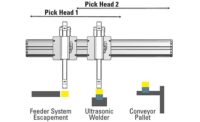Electromechanical servo press technology uses less energy than pneumatic or hydraulic assembly systems since they only draw current on demand – an energy reduction of 70-90 % is feasible with the electromechanical approach. As servo presses become more prevalent for joining processes, it is important to understand the different measurement technologies available and which technologies are most appropriate for your assembly process.
During a joining operation where an interference fit occurs, a signature force vs. displacement curve is generated.
Here are the key technologies and considerations when selecting an electromechanical servo press solution:
Position Measurement Technologies
LVDT. External to press system: Voltage signal (analog) could be less resolute than other approaches, but is less expensive.
External and incremental encoder: May cost extra engineering effort to select and design a strategy to measure from external encoder. Must be rehomed at startup after power outage
Internal Absolute Encoder: Best resolution and repeatability specifications. The press manufacturer selected an encoder matched to their provided motion controls system, and can also use this sensor for closed-loop control of the electromechanical servo press system.
Force Measurement Technologies
Torque derived from motor amplifier: Not as resolute as a sensor placed directly in the axis of force, since it is derived. Least expensive hardware approach, since no external sensor is required. Repeatability may not be satisfactory. This approach may require an external software or PC to analyze the motor torque data.
Strain Gage: Ideal for static processes, where pressing and holding is required - for instance, where a part must be held at a constant force while a robot welds the part in place. Strain gages yield nonlinearities in the low end and are susceptible to hysteresis – permanent mechanical deformation.
Piezoelectric: Ideal for dynamic processes and low force requirements, such as measuring when a plastic part snaps into position. Advantage of dual measuring ranges for flexible assembly stations where the measurement is extremely linear across the entire force range. Piezoelectric sensor characteristics are stable over time and temperature and do not require external excitation to function.
Strategies for Analyzing Live Data
PC-based analysis system: PCs are widely available and are relatively inexpensive. However, they are susceptible to IT policies, updates and malware – which can interfere with production systems. PCs are ideal for offline data analysis.
Embedded analysis system: Embedded computing systems designed for industrial use are the types of computers that should be on the plant floor. For 24/7 uptime manufacturing operations, a deterministic embedded computer should be used for data analysis and live signal processing. An embedded system evaluating live force/displacement data can even help to identify manufacturing flaws while the parts are being formed – saving cycle time and capturing non-nominal parts further upstream.
Strategies for Analyzing Offline Curve Data
Production software: Generally a large modular platform that can encompass all operations on a plant floor. May be integrated into production or quality systems but usually delivered with a hefty price tag.
Math software: More generic; a 3rd party developed open architecture platform that may be customized but requires extensive knowledge to program and maintain.
Vendor Developed Software: Supplied by press provider generally offers a user friendly application specific platform that offers powerful visualization and analysis of processes but is not easily customized.
Mechanical Considerations
The mechanical modules have two main components: servo motor and a linear screw. The motor mounting configuration comes in 3 varieties where the screw is limited to two types. There are advantages for each but some systems offer far greater benefits when compared to other types.
Integrated servo motor: Direct-driven; provides a stiff connection with no belt wear or backlash and requires less maintenance. Very compact in size compared to an externally mounted motor of equal force.
Externally mounted coupled servo motor: Direct-driven; provides a stiff connection with no belt wear or backlash and requires less maintenance
Externally mounted belt driven servo motor: Drive belts provide a point of failure and position accuracy due to belt wear or backlash. Drive belts require additional steps for maintenance crews for inspection and tightening.
Ball screw vs. planetary roller: Both are well-suited for most joining and press fit applications. The planetary roller can handle much higher loads with the same motor size due to the load is distributed over a greater contacting surface area. This reduces heat, increases efficiency and extends longevity.
Kistler Type 2151B… NCFH Joining Module with hollow shaft motor
Global support and service
Representatives vs. Direct engineers: If the assembly station will ship to another country for production, it is important to consider the support structure in place in this geography. Press manufactures either sell systems directly or use a network of representatives to handle technical support and replacement parts in these locales. Dealing direct with the manufacturer often yields the best technical support and product availability.
Contact your local Kistler representative or visit our website www.kistler.com.
Kistler Instrument Corp.
30280 Hudson Drive
Novi, MI 48377
Tel. + 1 248 668 6900





